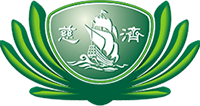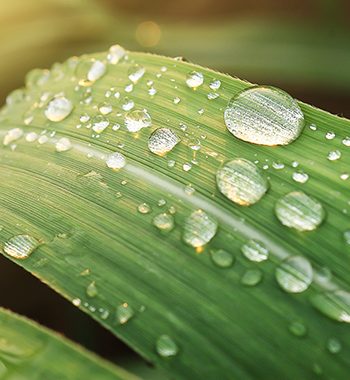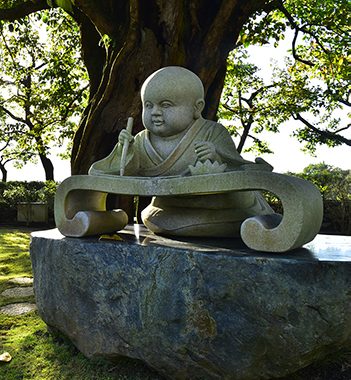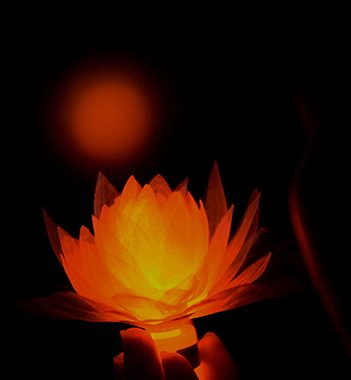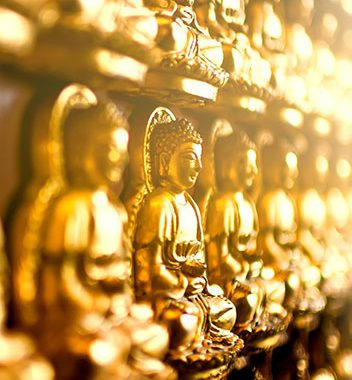The Medicine Buddha made twelve great vows, including the vow to lead sentient beings away from all kinds of hardships and disasters and guide them toward liberation. Sentient beings suffer from many physical and mental afflictions, especially from the Three Poisons of greed, anger, and ignorance. Sentient beings’ mental tribulations thus result in the 404 ailments, which bring anguish and suffering to their bodies and minds. The Medicine Buddha vowed to eliminate these afflictions and help people avoid the bonds of illness, alleviate their pain, and eliminate disaster. The Medicine Buddha Sutra is a Mahayana Sutra that praises the Medicine Buddha’s vows and practices.
After the Tzu Chi Merit Association was founded, on the 24th of every Lunar Calendar month, a distribution event known as the Tzu Chi Dharma Assembly was held. Later, to thank those who participated in the bamboo bank movement for their continuous donation of small sums of money, Master Cheng Yen decided to break with her earlier vow not to hold recitation services and began chanting the Medicine Buddha Sutra at the monthly distribution event. Master Cheng Yen hoped that this would encourage everyone to keep the Medicine Buddha’s twelve great vows in mind. In this way, she hoped that they would put these great vows into action to help and transform themselves and others. Subsequently, Master Cheng Yen gave three separate Dharma talks on the Medicine Buddha Sutra to address the mental and physical ailments of modern people. She hoped that this wondrous medicine would help bring harmony to the world and promote the radiant character of human nature.
A translation of the complete Teachings and Commentary on the Adapted Verses of the Sutra of Infinite Meanings is forthcoming.
In the Buddhist tradition, the Medicine Buddha is the Buddha of the Eastern Pure Land of Crystal.[1] The Medicine Buddha’s full name is Medicine Master Crystal Light Tathagata. He is also referred to as Vaidurya (crystal) as, according to descriptions, his land is pure and undefiled like a clear and radiant crystal. Medicine Master Tathagata is often portrayed with Sunlight Bodhisattva and Moonlight Bodhisattva by his side as his assistants. Together, they are called “The Three Sages of the East.”
According to the Buddhist teachings, the Medicine Buddha engaged in purifying practices for many kalpas. At the time Lightning Buddha was present in this world, Medicine Master made twelve great vows. Among these, he especially aspired to eliminate the illnesses and suffering of sentient beings, to help all sentient beings be replete with all roots, attain proper bodily appearances, have an abundance of material goods, be free from all accidents and troubles, and guide them to liberation.
Sentient beings have many afflictions; the Three Poisons of greed, anger, and ignorance give rise to 84,000 afflictions. These mental afflictions give rise to 440 different maladies of the mind, which cause our bodies and minds to suffer the torment of illness. The Medicine Buddha is known for his vows to remove these afflictions in order to free all beings from the entanglements of illness, to relieve them of suffering, and to eliminate disasters.
The full title of the Medicine Buddha Sutra is, “Sutra of the Merits and Virtues of Medicine Master Crystal Light Tathagata’s Original Vows.” It is one of the Mahayana sutras that praises the deeds and vows of the Medicine Buddha.
There are five Chinese translations of the Medicine Buddha Sutra. Currently, two versions are primarily used, the long edition and the short edition. The short edition was translated by Dharma Master Xuan Zang and is called, “Sutra of the Merits and Virtues of Medicine Master Crystal Light Tathagata’s Original Vows.” The long edition was translated by Dharma Master Yi Jing and is called, “Sutra of the Merits and Virtues of Medicine Master Crystal Light Seventh Buddha Tathagata’s Original Vows Spoken by the Buddha.” Master Cheng Yen’s commentary mainly uses Master Xuan Zang’s translation, while her explanation of Sakyamuni Buddha’s teachings on the Great Dharani Mantra uses Dharma Master Yi Jing’s translation, Sutra of the Merits and Virtues of Medicine Master Crystal Light Seventh Buddha Tathagata’s Original Vows Spoken by the Buddha, since this part of the text was not included in Master Xuan Zang’s translation.
Following the establishment of the Buddhist Tzu Chi Merit Association in 1966, on the 24th day of each lunar month, aid distributions were held. Initially, these distributions were called “Tzu Chi Dharma Assemblies.” Later, in order to thank the people who had donated to Tzu Chi’s charity work in response to the bamboo bank movement, Master Cheng Yen started offering Medicine Buddha prayer services during the monthly distributions at the Jing Si Abode, thereby breaking her earlier vow not to provide sutra prayer services or repentance services to the public. She did this to encourage everyone to firmly remember the Medicine Buddha’s twelve great vows and constantly take actions to save and transform themselves and others. This event was later renamed, “The Medicine Buddha Dharma Assembly.” These were the causes and conditions that led to Tzu Chi’s Medicine Buddha Dharma Assembly. Master Cheng Yen taught the Medicine Buddha Sutra three times. The first time she taught the sutra was at the Jing Si Abode in Hualien. At that time, in October of 1973, Typhoon Nora had devastated Taiwan.
At that time, Master Cheng Yen felt that in order to save the world, she first had to save people’s minds. She felt that promoting the teachings of the Medicine Buddha was the best way to do this. In commemoration of Tzu Chi Foundation’s Eighth Anniversary Celebration, Master hoped that everyone would listen to the sutra and reflect on themselves, repent, and diligently work to purify their own hearts and the hearts of others. In this way, people would be able to bring harmony to themselves and the world.
Thus, Master held the first Medicine Buddha Seven-Day Retreat at the Jing Si Abode from April 10 to April 16, 1974, and the event was held for three consecutive years until 1976. During this time, Master taught three times a day for a total of twenty-one times in each seven-day retreat. However, in the early days, her teachings were not recorded in their entirety, so when we transcribed them into written form, we would have been unable to completely present Master’s teachings on the Medicine Buddha Sutra from that first series of retreats.
The second time Master Cheng Yen expounded the Medicine Buddha Sutra was in May of 1984, at Tzu Chi Taipei branch office at Jilin Road, when Tzu Chi’s Taipei branch office was officially established. In order to inspire people’s love to build Tzu Chi Hospital, raise funds, and call for organ donations, beginning in March of 1985, Master Cheng Yen spent the last three days of every lunar month expounding the Sutra of the Merits and Virtues of Medicine Master Crystal Light Tathagata’s Original Vows. Each time, the room was fully occupied, with no empty seats.
Even while expounding the sutra, Master Cheng Yen continued to work on preparations for the construction of Tzu Chi Hospital and other related matters. After Tzu Chi Hospital opened, there were many other matters that Master needed to attend to, and she often had to travel. Thus, during the early summer of 1986, she temporarily halted her Dharma talks in Taipei. Soon, one by one, practitioners began to request for her to resume teaching. In 1987, due to their earnestness in seeking the Dharma, Master Cheng Yen decided to resume her teaching of the Medicine Buddha Sutra. She taught from November 18 to November 20 at the Taipei Armed Forces Officers’ Club on Yanping Road, at which point she concluded her teaching. From March 1985 to November 1987, Master gave teachings at a total of fifty-nine meetings, which were fully recorded.
The third time Master expounded the Medicine Buddha Sutra was at the Jing Si Abode in Hualien. At the beginning of the new millennium, Master Cheng Yen felt that there was an imbalance of the moral and ethical order in society and that interpersonal relations had become tense, full of confrontation, conflict, strife, and apathy. So, beginning on July 11, 2001, Master Cheng Yen again expounded the Medicine Buddha Sutra during the morning Dharma talk. She expressed that she was merely keeping everyone company in reading and studying the sutra as she explained the sutra line by line until everyone fully understood its meaning. As Master Cheng Yen taught, she targeted the illnesses affecting people’s bodies and minds. She gave a wonderful prescription to help the world, bring about peace and harmony, and enable the intrinsic light in all people to shine forth. On July 17, 2002, Master Cheng Yen finished teaching the sutra after a total of 157 lectures, all of which were audio-recorded. These teachings were published in July of 2006 by Tzu Chi Cultural Pub. Co. under the title, Eastern Crystal Medicine Master Buddha’s Great Vows.
When compiling these teachings, the Department of Dharma and History Compilation selected the lectures from 2001 as the basis. There were several reasons for this selection. First, in 2001, there were more lectures given compared to previous times. Moreover, due to the development of Tzu Chi’s Four Major Missions by that time, the content of the sutra was covered deeply and extensively. Finally, Master’s retelling of stories from the Buddhist Classics, her descriptions of Tzu Chi’s virtuous work and the current events in society, and her explanations of the many aspects of human nature were even richer and more relevant in the 2001 lecture series. Compared to the previously published Eastern Crystal Medicine Master Buddha’s Great Vows, the content of our compilation work is even more accurate and complete because we were able to listen to the original recordings, transcribe them, and proofread the transcripts word by word.
The editorial team abides by the principles of faithfulness, comprehension, and elegance. We follow Master Cheng Yen’s sequence of ideas and her tone of teaching so as to be faithful to her teachings and to the context. We have preserved the meanings, principles, and the flow of the words so that they are clear and easy to understand, and we have focused on the elegance of the writing so that the reader may find the teachings readable and enjoyable.
The writing on the cover is based on Master Cheng Yen’s calligraphy when she first transcribed the Sutra of Infinite Meanings and the Wondrous Lotus Sutra by hand. The inclusion of the words “teachings and commentary” in the book title represents how, while Master expounds the sutra, she makes use of events from the past to the present, across the long river of time. This affirms that “all Buddhas share the same path”; the teachings are just as relevant to modern living as they were when Sakyamuni Buddha originally taught them. The word choice is modern, while also retaining the usages of many ancient words. Parts of the teachings also contain original terms created by Master Cheng Yen, which differ from more common expressions, yet can explain the sutra’s key meanings even more thoroughly.
The original Chinese publication of this book was made possible by the Jing Si Abode’s monastic practitioners, Pure Practitioners, Tzu Chi volunteers, and others. A total of more than 130 participants helped to transcribe, proofread, and compile the content from the original audio recordings.
After editing, in pursuit of the utmost circumspection and reverence for the teachings, we requested volunteers and masters at the Jing Si Abode to read the transcription, and to give feedback on the matters and principles contained within, as well as any doubts they may have had as they read it. We finalized the draft only after repeated discussions and amendments.
For the Chinese version, designer Chen Jun-Liang’s team from Freeimage Design helped with the cover and proposed a text layout where each verse can inspire silent contemplation and each paragraph can stand on its own, while together they form an entire chapter. This design allows the Buddhist sutra to suit modern Chinese reading habits and to be more deeply integrated into our contemplation of daily living.[1]
Department of Dharma and History Compilation
Jing Si Abode, January 2016
[1] Also sometimes translated as “Lapis Lazuli” or “Aquamarine.”
[2] For the English translation of the book, in order to suit an English-speaking audience, we are retaining a regular paragraph structure for the text layout.
